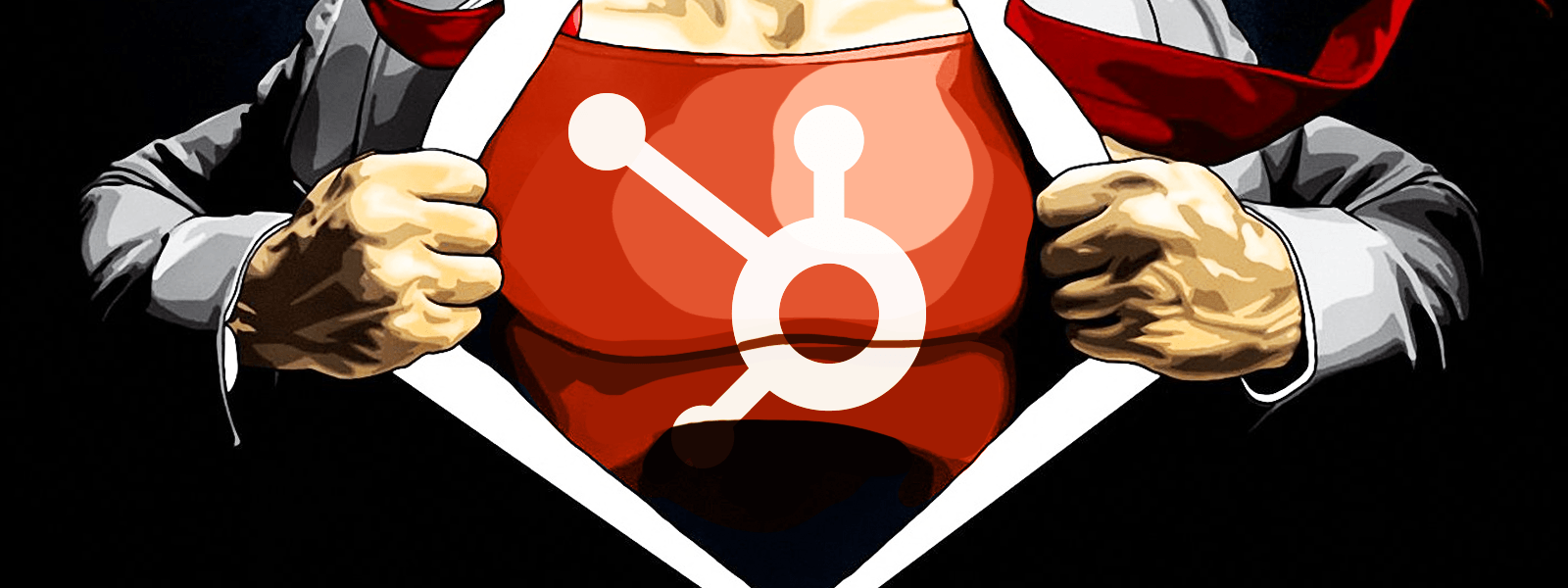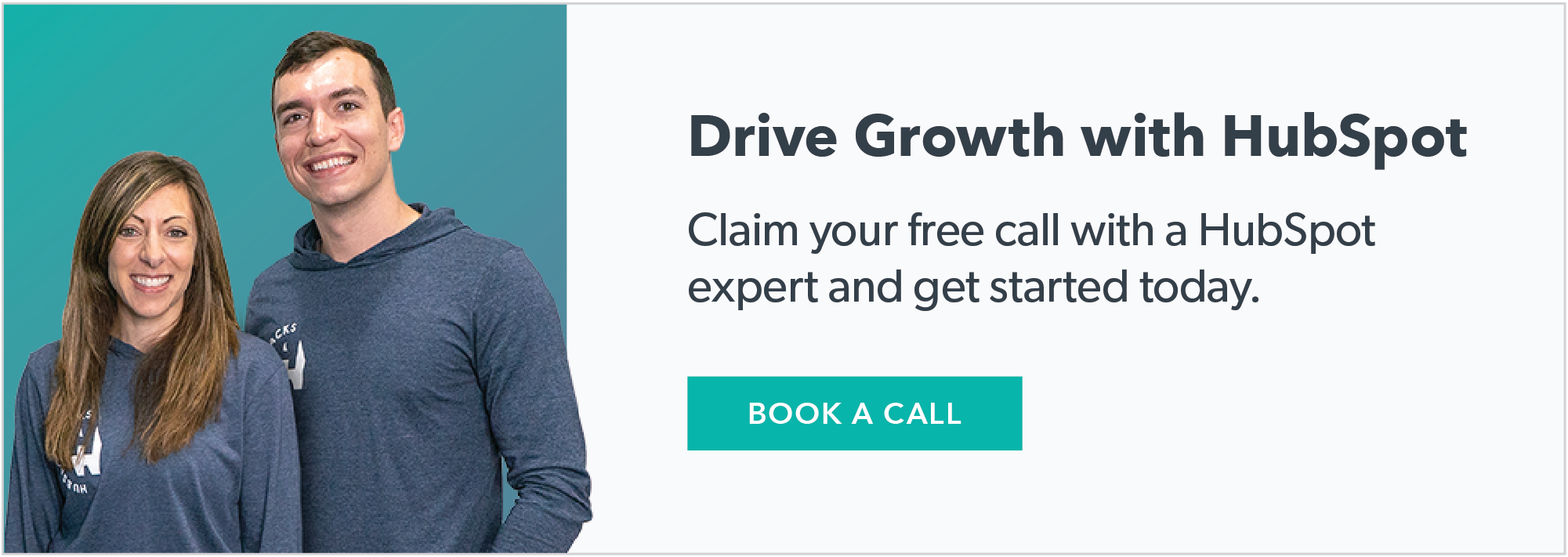Before we dive into the full HubSpot Sequences explanation, do you know how many emails it takes to make a sale?
While it can vary greatly, 70% of responses are generated by the 2nd to 4th email of a sales sequence, according to recent data, and the odds of landing an in-person conversation goes up with each touchpoint after that.
That means that following up and having a strategy for your sales outreach is critical. One email simply isn’t enough. That said, it would take a ton of extra time to track each new lead and email them at the appropriate times.
Luckily, sales automation makes this a lot easier, and there’s a great tool that empowers your sales team to save time and create consistency in their outreach: HubSpot sequences. Not only do these allow you to automate email tasks, but they provide personalization tools and performance tracking, empowering your sales team to focus on the tasks that make the most impact.
Need help setting up sequences, or optimizing your HubSpot to better grow your business? Learn about our HubSpot services, or read about the basics of HubSpot.
Contents:
- What are HubSpot sequences?
- HubSpot sequence example
- Difference between a workflow and a sequence in HubSpot
- How to create a HubSpot sequence strategy
- How to set up HubSpot sequences for your business
- Taking advantage of Dynamic Sequences in HubSpot
- What should you include in a HubSpot sales sequence?
- Best practices for your sequences
What are HubSpot sequences?
HubSpot sequences are a set of tools in the Sales Hub that allow you to automate much of your sales process — more specifically, to automate messages to your prospects, saving you time in your sales outreach. HubSpot sequences They integrate with your existing inbox and make it easy to personalize and send emails quickly. Sequences are only available in Sales Pro and Sales Enterprise so far.
HubSpot sequences allow you to:
- Create custom 1-to-1 email templates to send sequentially to a targeted audience of your choice. When creating sequences, you can choose from pre-made sequences HubSpot has already made templates for (like “recent conversion” or “trade show follow-up”), or you can create your own from scratch.
- Customize the timing of the emails to send at whichever pace makes sense for your team.
- Create tasks to follow up with contacts (like making a call, or connecting with them on LinkedIn), so nobody falls through the cracks. You can add as many tasks as you want, but you’re limited to five emails per sequence.
You can automatically unenroll contacts from the sequence when they complete the desired action, like booking a meeting or replying to your email, so you can avoid sending excessive emails as contacts move down your funnel. (These triggers to unenroll contacts cannot be turned off, but can be edited).

HubSpot sequences are a great way to automate and optimize your sales emails — but not at the cost of personalization, which is what makes all the difference. It’s also a great opportunity to get these emails out of individual sales reps’ inboxes and into a place where you can track and monitor each email’s success (and then optimize it for better results).
Automation tends to require some upfront time investment to get everything set up, but once the systems are in place, you may be shocked at how much time you save on mundane tasks.
HubSpot sequence example
Sequences can look different depending on your goal. You might have a sequence dedicated to introducing prospects to your company, an engagement sequence to share valuable content and build rapport, or a conversion sequence to get them to sign up for a consultation call.
Here’s a sample of a basic HubSpot sequence that incorporates all three of those:
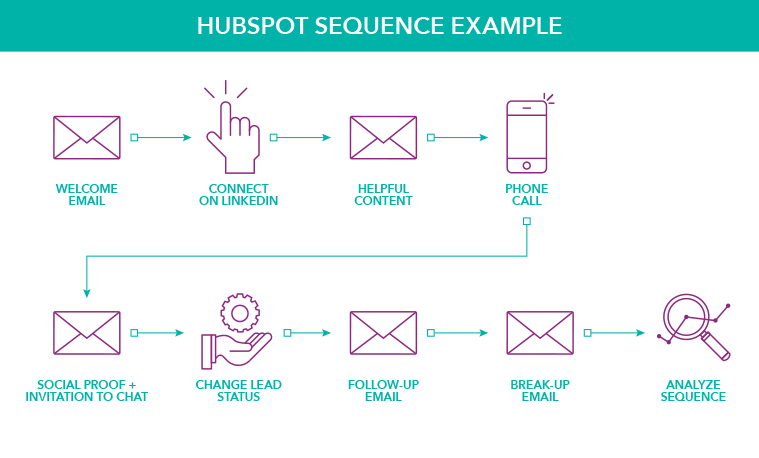
- Email 1: Welcome Email
- Task 1: Connect with Prospect on LinkedIn
- Email 2: Helpful Content
- Task 2: Phone Call
- Email 3: Social Proof + Invitation to Chat
- Task 3: Change Lead Status
- Email 4: Follow-up Email
- Email 5: Break-up Email
- Task 4: Analyze Sequence
This type of sequence can provide a personalized experience for your prospects while automating some of the more tedious tasks your sales team deals with.
Consider a few examples of when you might use HubSpot sequences
- Proposal follow-up: Keep clients engaged after a proposal with well-timed emails to answer questions, highlight key benefits, and show responsiveness. HubSpot sequences simplify this process, helping reps stay top of mind and close deals.
- Price-based follow-up: Address pricing concerns with a personalized sequence. Explain value, share cost justification, and follow up based on interest. HubSpot’s automation lets reps handle questions, helping prospects see value in the investment.
- No-show demo rebooking: For missed demos, use understanding, flexible follow-ups to rebook. Automated emails highlight demo value, rescheduling options, and personalized incentives, increasing the likelihood of getting prospects back on track.
Difference between a workflow and a sequence in HubSpot
Newer HubSpot users often confuse workflows and sequences in the platform. Both tools feature automation tasks, such as nurturing leads, automating tedious sales, or notifying team members of timely information. Here are some key differences between them.
HubSpot Sequences vs Workflows:
|
HubSpot Sequences |
HubSpot Workflows |
|
|
Used by |
Used by sales teams to establish a connection with a lead through a series of follow-ups |
Used by marketers (or in some companies, by customer service teams) |
|
Great for |
Closing deals on qualified leads |
Nurturing new leads in earlier stages of buyer journey |
|
Level of personalization |
Highly targeted content for the individual |
Content customized more broadly to the audience segment |
|
Contacts enter by |
Contacts manually enrolled in the sequence, 1 to 50 at a time |
Contacts enter workflows automatically from activities like website signups, field property changes, etc. |
|
Typical number of contacts |
Small number of qualified contacts |
Larger number of contacts |
|
Ending the process |
Contact unenrolled after they reply to an email, or book a call |
Contacts exit upon finishing workflow, or other custom triggers |
|
Type of content |
Lighter on media and style, more text focused |
Stylized and image-rich emails |
|
Contacts have been assigned to a salesperson? |
Yes: a 1-1 relationship has been established |
No: contacts are typically earlier in the buyer journey |
To get you a better grasp of these differences, check out this video explaining when you might want to use each:
Coupled with other useful features like workflows and HubSpot playbooks, a great set of sales sequences can make it much easier to scale your business.
How to create a HubSpot sequence strategy
As the saying goes: “without strategy, execution is aimless. Without execution, strategy is useless.” We live by that mantra at Simple Strat, so before we explain how to set up sequences, we want to emphasize the importance of knowing your strategy.
Even though individual sales reps might have their own ideas and tactics they’ve used in the past, the best practice is to create an overall strategy for your HubSpot sequences based on their experiences.
Your initial communication strategy sets the stage for each contact’s view of (and relationship with) your company, so let’s give it the attention it deserves:
Know your personas
The first step is knowing who you’re writing to. If you don’t have a deep understanding of the challenges, needs, and goals that your prospects have, it will be difficult to communicate effectively and write your sales emails in a way that will resonate with them.
Take time to figure out how you will create different types of sales sequences for these personas. If you only plan on creating one sequence for all your customers, you’re missing an opportunity to tailor your content to their individual pain points. Especially when marketers have noted a 760% increase in revenue from personalized and segmented campaigns.

Talk to your sales reps
Your sales team is a valuable resource when it comes to knowing what works and what doesn’t. So, take the time to ask them what has been successful in the past. Consider sending out a survey asking for input or send test sequences to top reps to ask for their feedback.
This will also help to get buy-in from your sales team when you’re ready to launch your sequences and want salespeople to implement them in their outreach.
Add a personal touch
A huge point in favor of HubSpot sequences is that you can easily personalize these emails based on data in your CRM. If you keep track of information like a prospect’s biggest challenge, you can add a personalization field to pull that into your email and mention it in your outreach. This value is huge, with personalized experiences creating an average increase of 20% in sales, according to Monetate.

You can also edit the email templates for a specific contact when you enroll them in the sequence. This is another great opportunity to add a personal touch and make a bigger impact on your prospect.
Track what works (and what doesn’t)
Set up multiple sequences and test what works. Does one sequence generate a lot of meeting requests? Does another close a large number of deals? By using HubSpot to set up your sequences, you’re able to track this information and improve your outreach based on it.
A/B test your sequences
HubSpot sequences also now include A/B testing, making it easy to refine emails by testing elements like subject lines, body copy, CTAs, and personalization. This helps sales teams improve engagement and boost conversions by focusing on what works best. Set up is simple: create variations, split sends, and let the data guide you.
Learn more about A/B testing sequences.
How to set up HubSpot sequences for your business
Okay, so you’ve established your communication strategy and it’s time to set up your first sequence.
Before we dive in, a few things to remember. To create, edit, and execute HubSpot sequences, your account needs to have the following:
- An assigned Sales Hub Professional, Enterprise, Service Hub Professional, or Enterprise seat
- A connected personal email address (you can’t send sequence emails with a team email address connected to the conversations inbox)
- Sequences permissions
The following steps will be easier to follow visually, so watch our HubSpot sequences tutorial video for a better understanding of how the sequencing setup works. This video goes over HubSpot sequence templates, setting up your own sequences from scratch, and some pro tips to get the most out of your sequences.
Before you get started
When using sequences, bear in mind that there’s a limit to the number of them you can create in your account. To check how many sequences you have so far, look at the top right corner of your Sequences dashboard.
Also, remember that any tasks in a sequence will be assigned to whichever user enrolled the contact into the sequence.
Creating and setting up sequences
Once you’re in the sequences section, you can choose between starting a new sequence from scratch, or using one of the pre-made templates.
1. Select the type of sequence to create.The pre-made templates cover a helpful range of common use cases, and will require minor customization to get set up. If you start from scratch, you’ll have much more flexibility with what your sequences do (though note that if you haven’t already created saved templates of your own, you’ll need to write them as you go). When you’re ready, hit Create Sequence.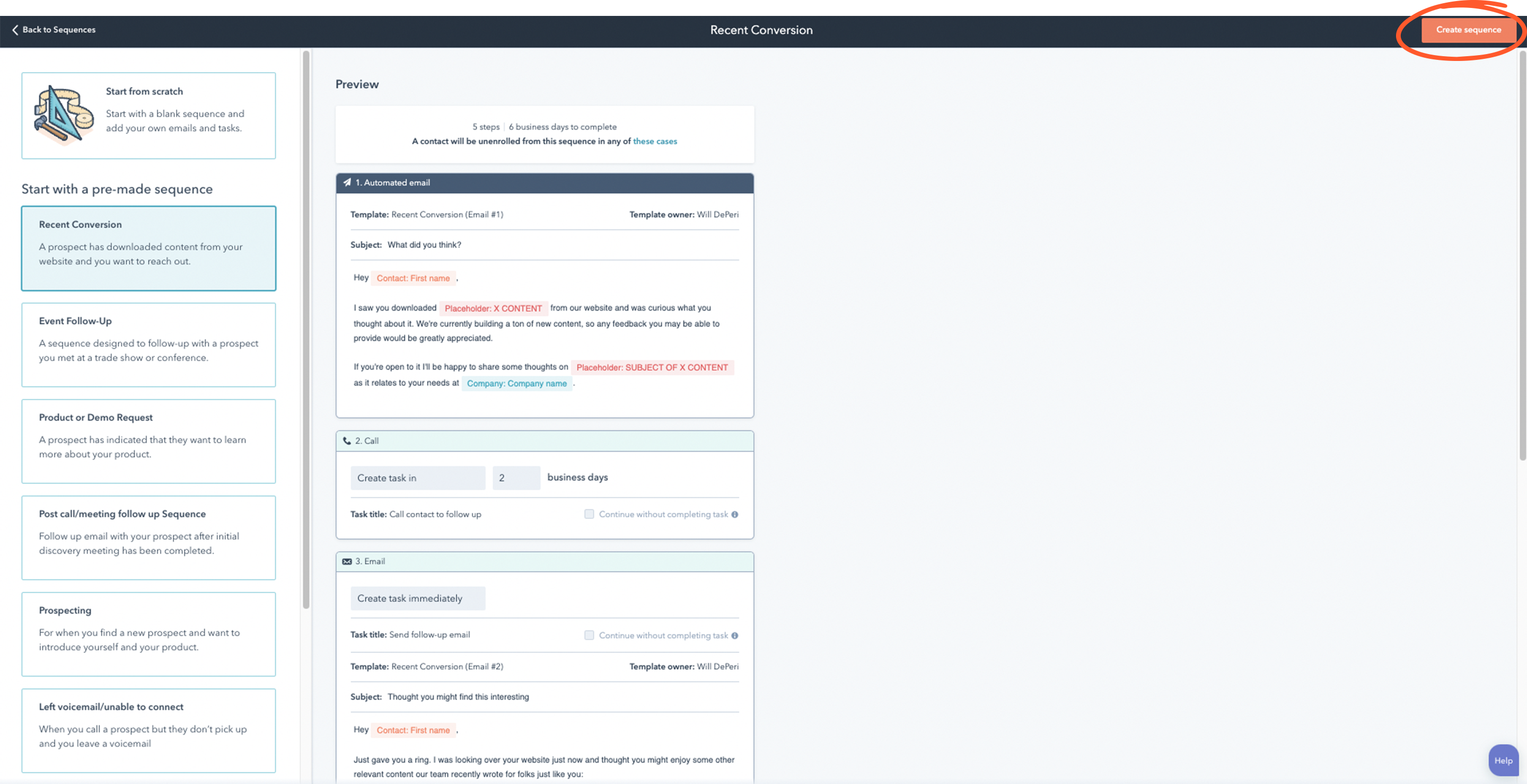
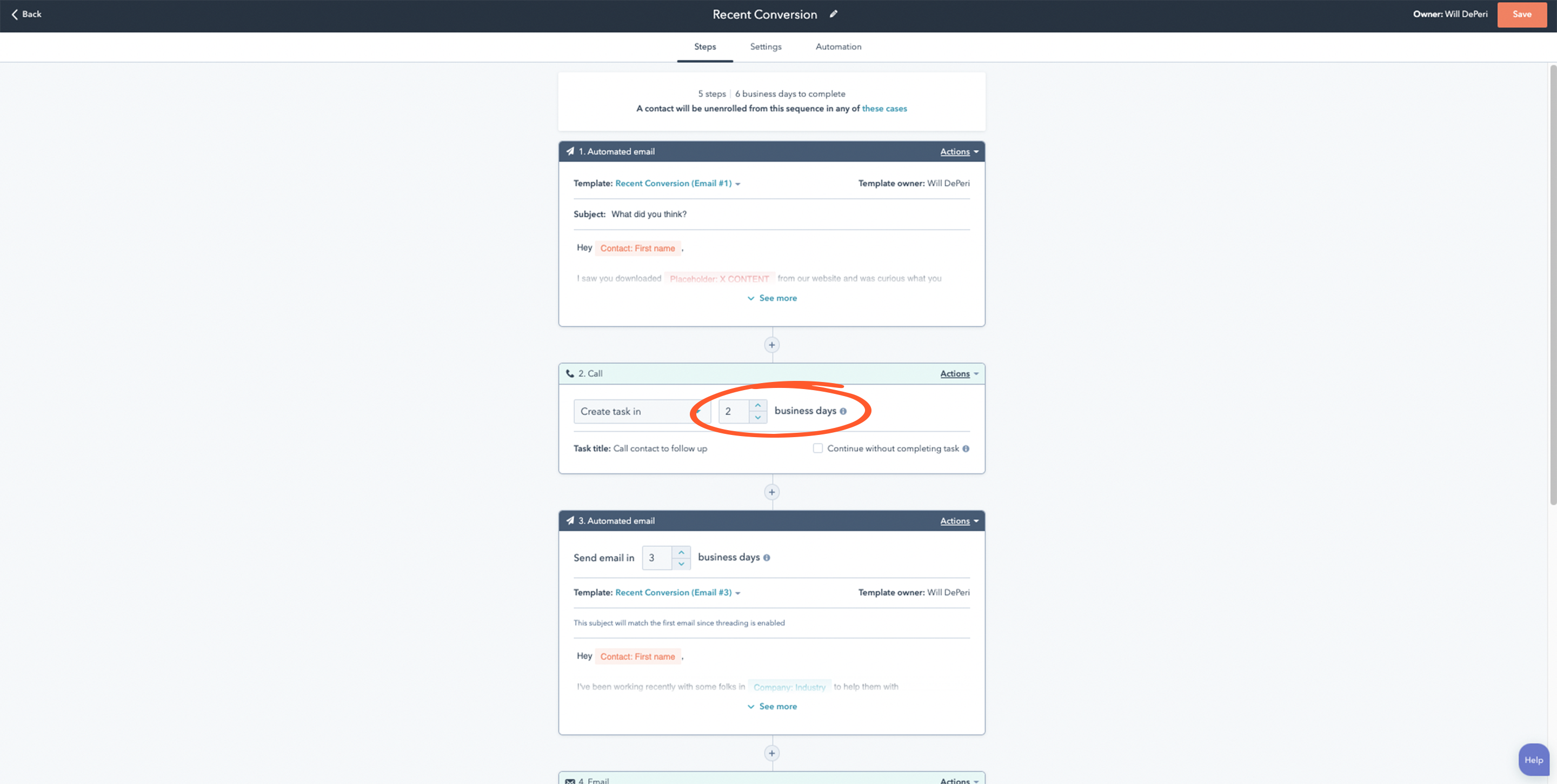
3. Add actions. From the side panel on the right, you can select actions to add, such as automated emails, or task reminders. A useful task reminder might be to call the contact, or to add them on LinkedIn if they don’t respond after a period of time. HubSpot will not complete these tasks for you, but these reminders will let you know when it’s time to take each action.
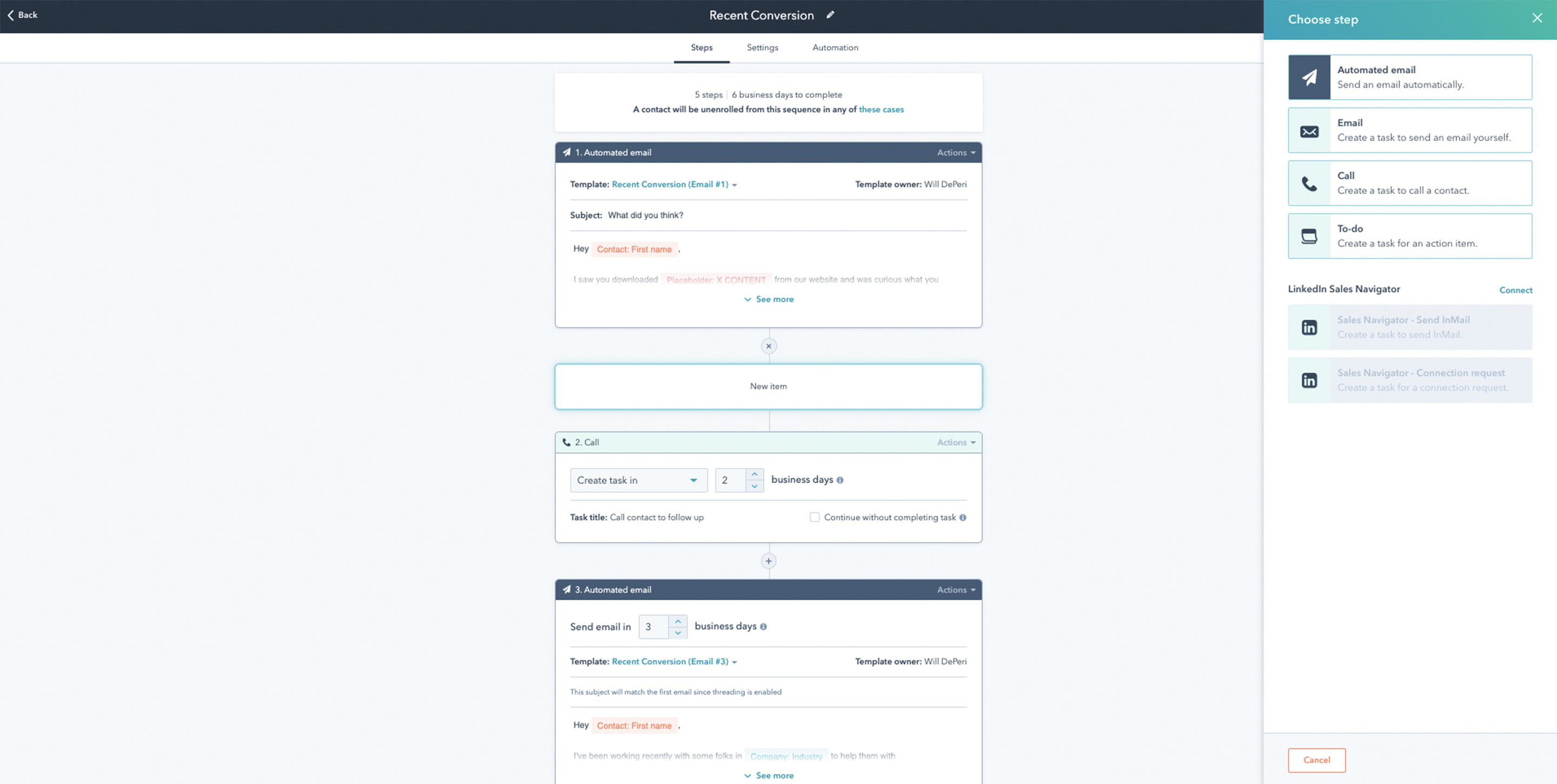
4. Customize your emails. Within each email, you can customize the content to suit your needs, and add custom contact tokens to autofill text such as names or company names. The templates provide the bones for a good email but aren’t ready to go as-is, so at a bare minimum you’ll need to swap out placeholder text for your own.
How to enroll contacts in a sequence
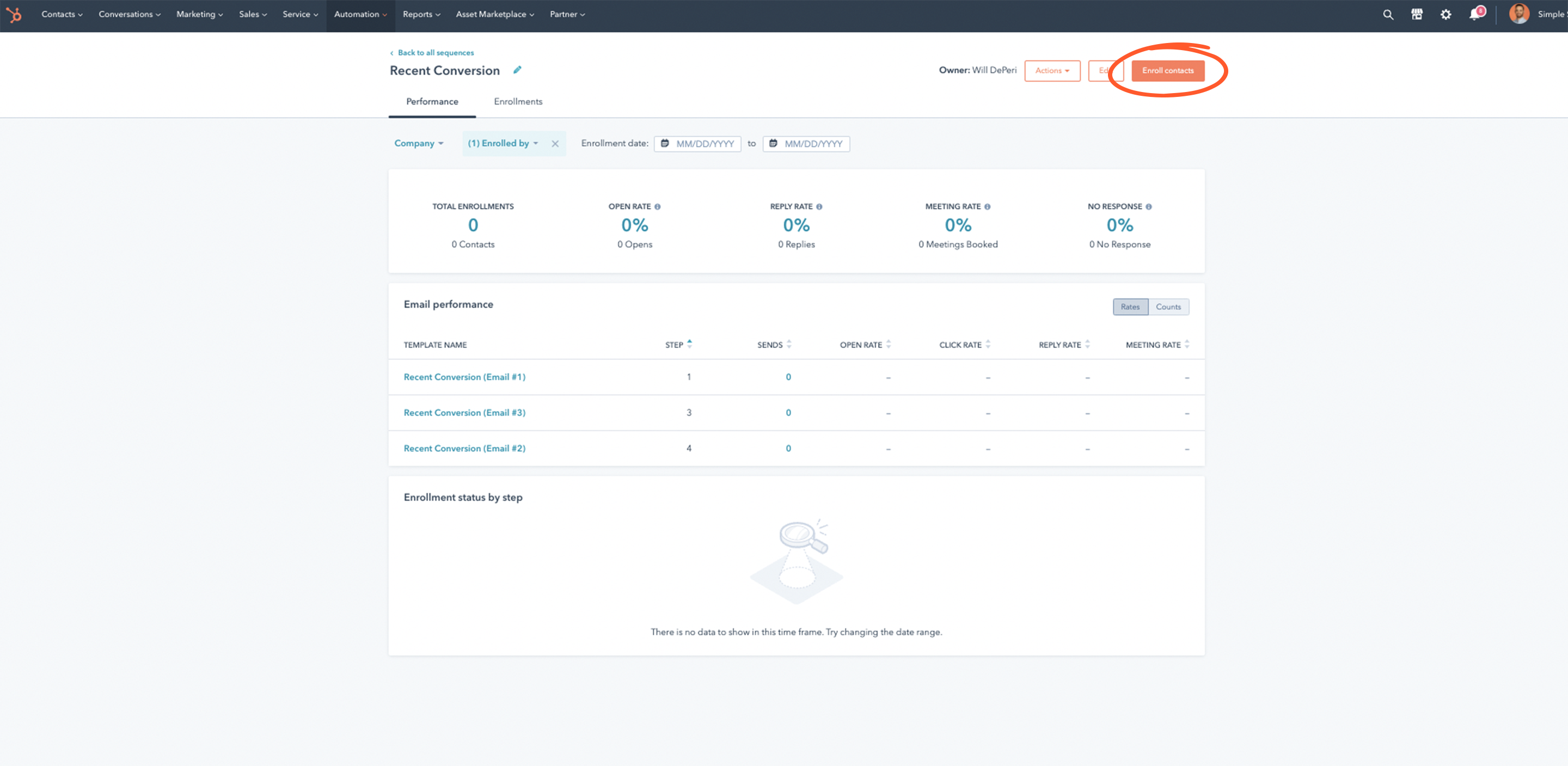
Once you’ve got your sequence set up, save it (using the button in the top right), and you’ll be taken to a page where you can start sending contacts into it.
The “Enroll” button lets you send a contact into the sequence. This will open up a window with more customization options, such as the timing of an email.
Once you’ve set this up and confirmed, your “Total Enrolled” contact count will increase (this may take a page refresh to show up).
Note that if you started using the Sales Starter plan early enough, you may have been “grandfathered in” and have access to sequences, but only on a minimal level, so you can only enroll 1 contact at a time.
Tracking Sequence Success
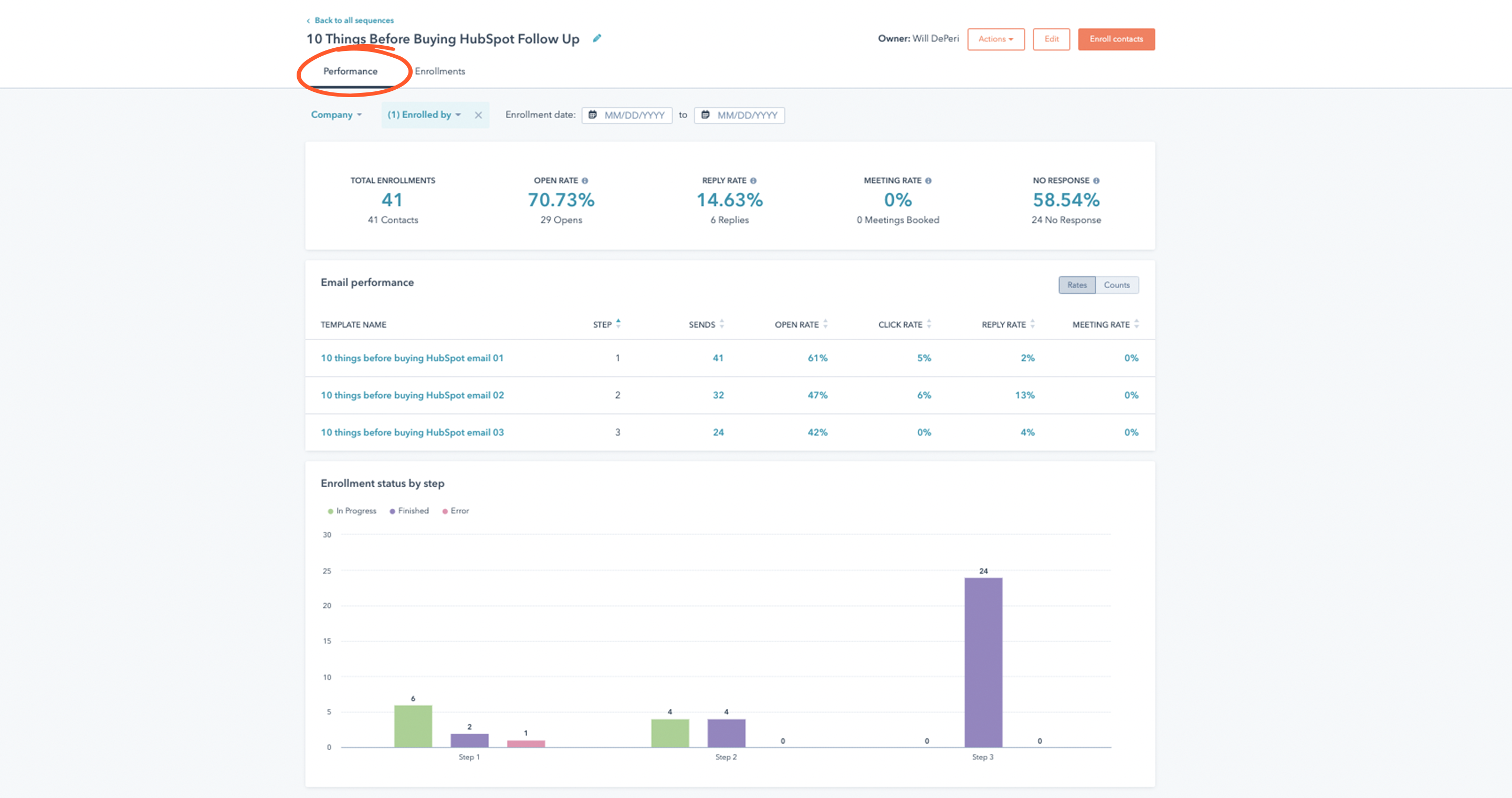
Further down the screen, you can see each enrolled contact and their status. This lets you get a quick sense for how your emails are performing. With this kind of data, you can get a much better understanding of where the weak spots are in your sales communications, so you know what to work on.
That said, we’ve found many people don’t actually know which type of email content gets consistent results, so let’s dive into that.
Take advantage of Dynamic Sequences to drive your sales team's efficiency
Is your team juggling tons of leads, but only a few are actually ready to connect? What if your system could send the hottest leads straight to your reps, while automatically nurturing the rest? HubSpot’s dynamic sequences make that happen, combining automation with a personal touch so your team can close more deals, faster.
Here’s how it works: dynamic sequences send personalized, automated emails to nurture leads, but only surface manual tasks when contacts engage—like opening or clicking an email. That way, reps spend time with leads that are genuinely interested, while the sequence takes care of everyone else. Compare that to static sequences in other tools, where every prospect gets the same treatment, no matter how cold they are.
Here’s why HubSpot’s Dynamic Sequences are such a game changer:
- Focus on the leads that matter: Dynamic Sequences automatically flag hot leads, freeing reps to spend their time where it counts.
- Flexible multi-channel outreach: Reps can switch easily between automated emails and manual follow-ups, adjusting based on a lead’s engagement.
- Real-time insights: Enhanced reporting lets reps see engagement right away, making it easy to adjust their approach on the fly.
With Dynamic Sequences, your sales team spends less time on admin work and more time connecting with the right people.
What should you include in a sales sequence?
The short answer? Your HubSpot email sequences need to have valuable content. It’s important to use these emails as an opportunity to bring value to your potential customers and show them that you empathize with their challenges.
To do this, offer solutions to those challenges with your content from the start, and it will become much easier to offer your products as a solution down the road. The content you include in these emails will vary based on your products and services, but here are a few ideas to get you started:
- Case studies
- Webinars
- Insight reports
- Videos
- Blogs on industry topics
- Personalized surveys
- Testimonials
- Referrals
Ultimately, the purpose is to add value for your prospects and build a relationship they can trust.
Best practices for HubSpot sequences
Want your HubSpot sequences to actually convert? Follow these straightforward best practices to make your sequences more targeted, engaging, and effective—so you can start seeing real results.
- Set a clear goal. Every sequence should start with a goal that guides what you’re saying and how often you’re reaching out. Whether it’s booking a meeting, sharing resources, or nurturing interest, a clear goal keeps things focused.
- Make it personal and targeted. Personalization means more than just using a contact’s name—tailor your content to fit their needs. Use segmentation to reach the right groups and make each sequence feel relevant and valuable.
- Focus on solving real problems. Your content should answer questions, tackle pain points, and solve issues your contacts care about. Sequences that address real needs get better engagement.
- Optimize for mobile. Most emails are opened on mobile, so make sure they’re easy to read on small screens. Keep your message concise, and make your call to action (CTA) easy to find and click.
- Use clear calls to action. Each email should guide the recipient to do something specific. But don’t just ask for a meeting—mix it up by asking them to watch a video, read a guide, or connect on social.
- A/B test and improve. Test one element at a time (like the subject line or CTA) to find what works best. HubSpot’s A/B testing makes it easy to see what’s driving engagement, so you can keep improving.
- Track and share what you learn.Document what you’re testing and the results. Sharing these insights keeps everyone in the loop and helps the whole team get better results.
We covered these practices and more in a recent webinar, condensed here for your convenience.
Learn more about Simple Strat's webinars.
-----
When used correctly, HubSpot sequences can be a powerful tool for your sales team to interact with prospects and close more deals, especially when they’re backed by a smart strategy.
What’s worked for you? Any sales sequence pro tips or success stories from your company? Share them in the comments below!
